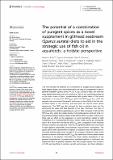Por favor, use este identificador para citar o enlazar a este item:
http://hdl.handle.net/10261/349223COMPARTIR / EXPORTAR:
 SHARE SHARE
 CORE
BASE CORE
BASE
|
|
| Visualizar otros formatos: MARC | Dublin Core | RDF | ORE | MODS | METS | DIDL | DATACITE | |

| Título: | The potential of a combination of pungent spices as a novel supplement in gilthead seabream (Sparus aurata) diets to aid in the strategic use of fish oil in aquafeeds: a holistic perspective |
Autor: | Ruiz, Alberto CSIC ORCID; Sanahuja, Ignasi; Andree, Karl B.; Furones, D.; Holhorea, Paul George; Calduch-Giner, Josep A. CSIC ORCID; Pastor, Jose J.; Viñas, M.; Pérez-Sánchez, Jaume CSIC ORCID; Morais, Sofia; Gisbert, Enric | Palabras clave: | Phytogenics Spices Anti-inflammatory DHA/EPA ratio Digestion Bile salts Docosahexaenoic acid Microbiota |
Fecha de publicación: | 25-sep-2023 | Editor: | Frontiers Media | Citación: | Frontiers in Immunology 14: 1222173 (2023) | Resumen: | This work studied the potential of a combination of pungent spices (capsicum, black pepper, ginger, and cinnamaldehyde) to be used as a supplement in diets of gilthead seabream (Sparus aurata; 44.1 ± 4.2 g). During 90 days, fish were fed three experimental diets with low inclusion of fish oil and containing poultry fat as the main source of lipids, supplemented with graded levels of the tested supplement: 0 (control), 0.1 (SPICY0.1%), and 0.15% (SPICY0.15%). As a result, the pungent spices enhanced the growth performance, the activity of the bile-salt-activated lipase in the intestine, and decreased fat deposit levels within enterocytes. The SPICY0.1% diet reduced the feed conversion ratio and the perivisceral fat index and lipid deposits in the liver. Moreover, the ratio of docosahexaenoic acid/eicosapentaenoic acid in fillet increased in fish fed the SPICY0.1% diet, while the hepatic levels of docosahexaenoic acid and total n-3 polyunsaturated fatty acids increased in fish fed the SPICY0.15% diet. Furthermore, there was an effect on the expression of some biomarkers related to lipid metabolism in 2-h postprandial fish (fasn, elovl6, scd1b, cyp7a1, lpl, and pparβ), and in 48 h fasted-fish fed with the SPICY0.1% diet, a regulation of the intestinal immune response was indicated. However, no significant differences were found in lipid apparent digestibility and proximate macronutrient composition. The spices did not affect biomarkers of hepatic or oxidative stress. No differences in microbial diversity were found, except for an increase in Simpson’s Index in the posterior intestine of fish fed the SPICY0.1% diet, reflected in the increased relative abundance of the phylum Chloroflexi and lower relative abundances of the genera Campylobacter, Corynebacterium, and Peptoniphilus. In conclusion, the supplementation of gilthead seabream diets with pungent spices at an inclusion of 0.1% was beneficial to enhance growth performance and feed utilization; reduce fat accumulation in the visceral cavity, liver, and intestine; and improve the fish health status and condition. Results suggest that the tested supplement can be used as part of a nutritional strategy to promote a more judicious use of fish oil in fish diets due to its decreasing availability and rising costs. | Versión del editor: | https://doi.org/10.3389/fimmu.2023.1222173 | URI: | http://hdl.handle.net/10261/349223 | DOI: | 10.3389/fimmu.2023.1222173 | E-ISSN: | 1664-3224 |
| Aparece en las colecciones: | (IATS) Artículos |
Ficheros en este ítem:
| Fichero | Descripción | Tamaño | Formato | |
|---|---|---|---|---|
| Sparus_aurat_Ruiz_Art_2023.pdf | 5,27 MB | Adobe PDF |  Visualizar/Abrir |
CORE Recommender
Page view(s)
19
checked on 27-abr-2024
Download(s)
12
checked on 27-abr-2024
Google ScholarTM
Check
Altmetric
Altmetric
Este item está licenciado bajo una Licencia Creative Commons

